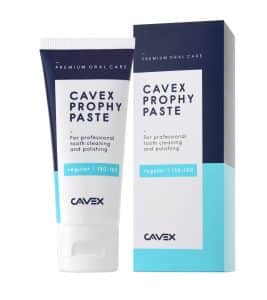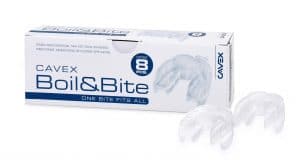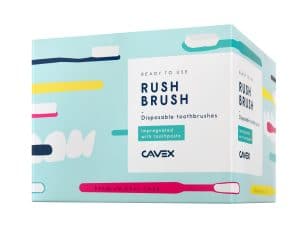Dealers
Users
General






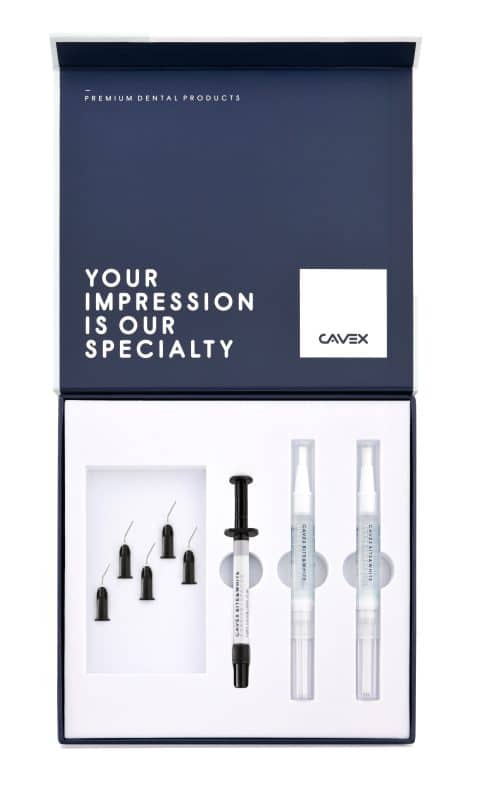
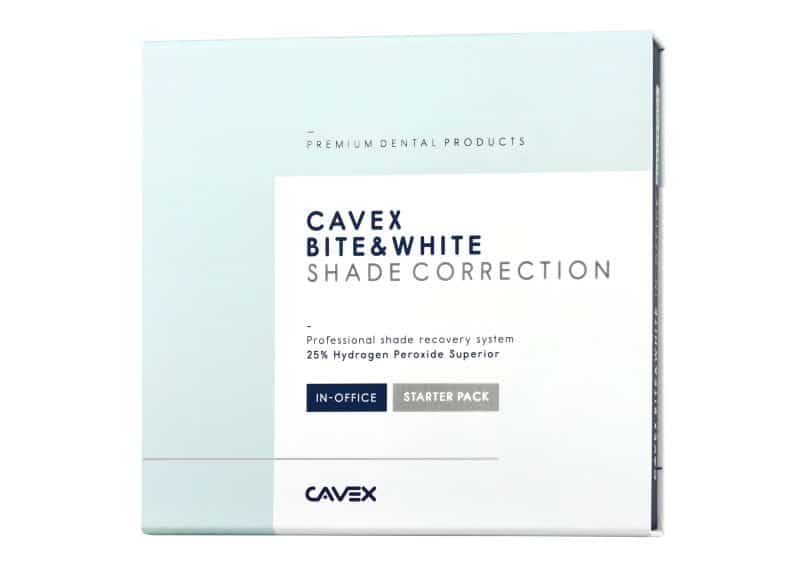
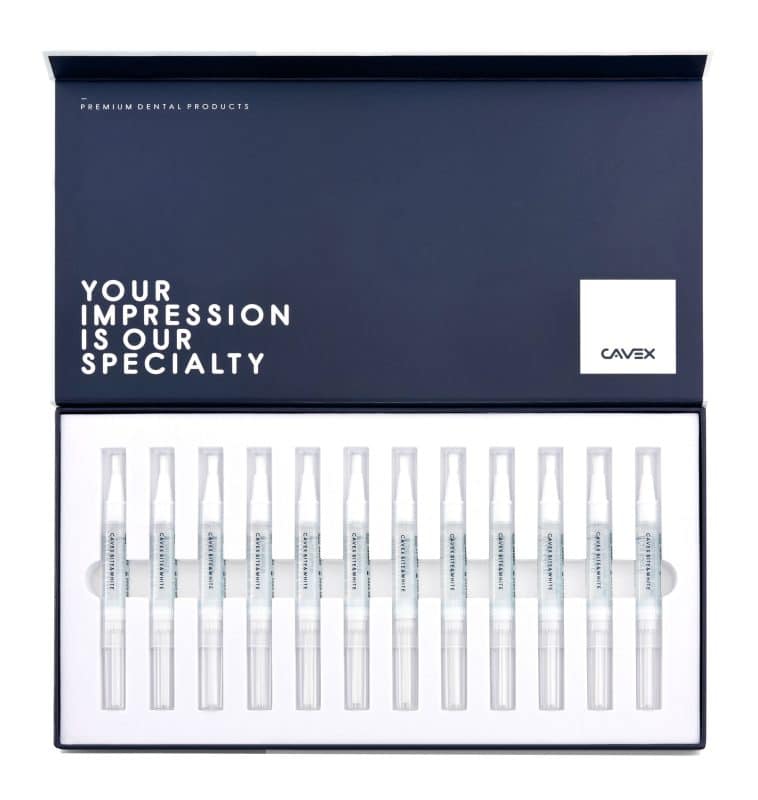
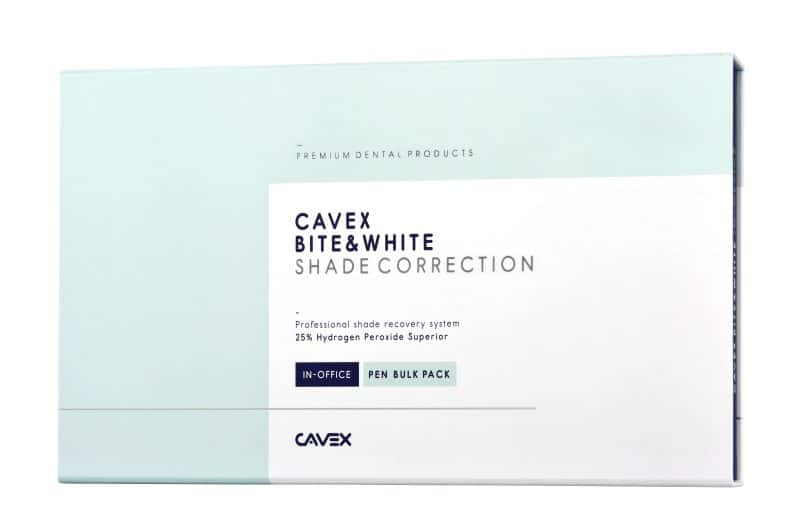
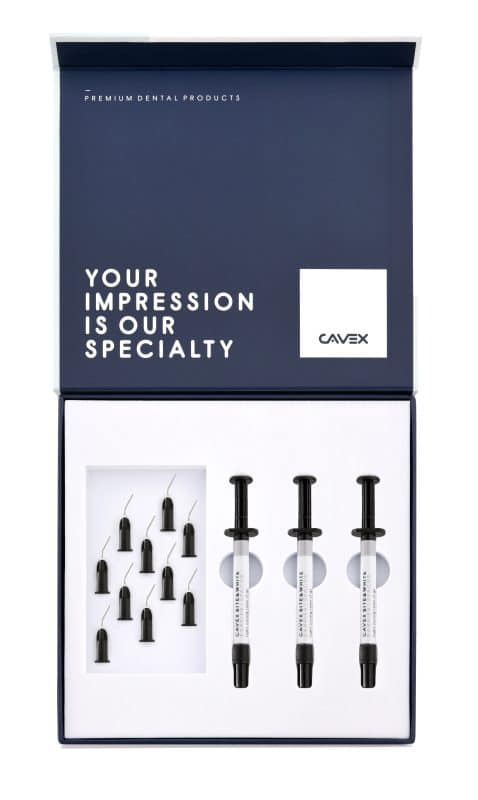
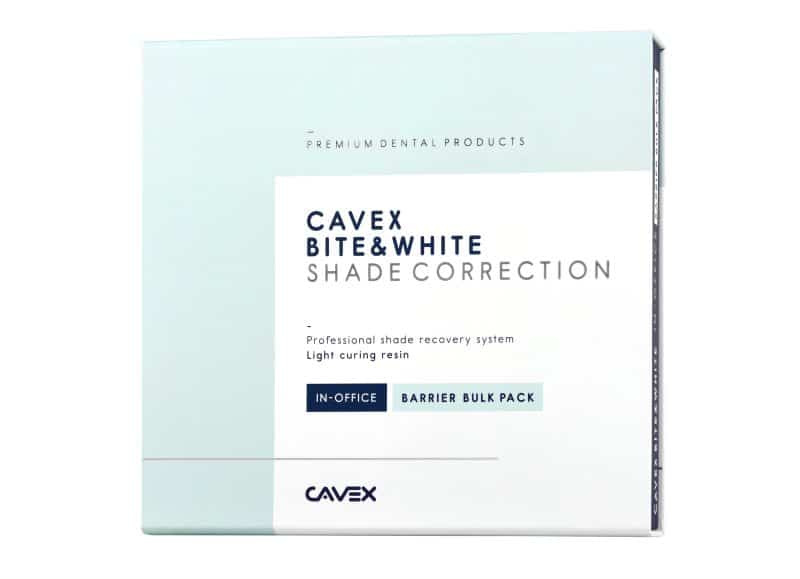
Cavex Bite&White Shade Correction
Cavex Bite&White Shade Correction is a fast, safe and effective system for restoring the natural tooth color. It is an In-Office system, so the entire procedure is carried out by the dentist in the dental practice. The revolutionary gel in the system makes it possible to restore the original tooth color with only 2 to 3 applications in 1 treatment.
The Shade Correction System is based on 25% Hydrogen Peroxide Superior (HPS). This revolutionary gel, developed and patented by Cavex, is based on reactive oxygen added in the form of stabilized, encapsulated hydrogen peroxide. Upon contact with saliva, the pure hydrogen peroxide in the HPS gel is rapidly broken down into oxygen and water. This process creates free radicals that attack the carbon double bonds in chromophores that are the source of most discoloration in teeth.
Due to the unique formula, the HPS gel works extremely fast. This minimizes treatment time and thus the risk of sensitivity. The thermo-reversible properties of the gel ensure that it stays perfectly in place during the treatment which maximizes the final result. The system consists of a unique applicator pen with a brush for maximum control during application and a protective barrier to protect the surrounding soft tissue.
More information about this product? Download the brochure below. Visit our distributor’s page to discover where the product is available.
Features
- Very fast results
- Based on 25% Hydrogen Peroxide Superior
- Only 2 to 3 applications in 1 treatment
- Full control over the application through the brush
- The thermo-reversible HPS gel stays perfectly in place
- Ready to use product, no mixing required
- Can be stored at room temperature
- Available in: Starter Pack (2x pen & 1x barrier + 5 tips), Pen Bulk Pack (12x pen), Barrier Bulk Pack (3x barrier + 10 tips)
- Class I Medical Device
-
Product Photos
-
Starter Pack
-
Pen Bulk Pack
-
Barrier Bulk Pack
-
Instructions For Use
-
FAQ
-
What causes tooth discoloration?
Discoloration of teeth can have an intrinsic and/or an extrinsic cause. When the discoloring has an intrinsic cause, it means there are small cracks in the enamel and dentin. Molecules within these cracks discolor and cause the discoloration of teeth. Extrinsic causes are stains on the teeth’ surface. The gel in Cavex Bite&White Shade Correction handles both intrinsic and extrinsic discoloration. During the decomposition of the hydrogen peroxide in water and oxygen, energy is released in the form of radicals. These radicals penetrate the enamel without affecting it and break down the discolored molecules.
-
What is Hydrogen Peroxide Superior (HPS)?
The gel in the Cavex Bite&White Shade Correction is based on the – by Cavex developed and patented – “Hydrogen Peroxide Superior (HPS) technology”. The HPS technology keeps the very pure hydrogen peroxide stable. As a result, the gel is immediately ready for use, without pre-mixing. Due to the unique composition of the HPS gel, the hydrogen peroxide works faster and more effectively, so that the maximum result is achieved after just two or three treatments. This saves time for the dentist and minimizes potential tooth sensitivity, as sensitivity increases the more often treatment is repeated.
-
Does the gel in Cavex Bite&White Shade Correction cause sensitivity to teeth or gums?
Cavex Shade Correction should always be used in combination with Cavex Bite&White Barrier/Spacer. By applying and curing the Barrier on the gums, the gel should not come into contact with the gums, preventing gum sensitivity. Sensitivity to the teeth is possible and varies from person to person. In case of tooth sensitivity, a desensitizing product like Cavex ExSense could be considered after the treatment. Click HERE for more information about Cavex ExSense.
-
How long does a treatment take?
How long a treatment takes depends on various factors like the initial and desired tooth shade, but also the patient’s age. On average, with Cavex Bite&White Shade Correction the maximum result is reached within a maximum of two or three sessions.
-
How many times and how long does the gel need to be applied on the patient’s teeth?
Due to the unique composition of the HPS gel, the hydrogen peroxide works faster and more effectively. A session with Cavex Bite&White Shade Correction takes just two or three applications of ten to fifteen minutes to achieve the maximum result.
-
When will I be able to eat and drink after the treatment is finished?
It is advised not to smoke, eat or drink any acidic or strong-colored products (like black coffee) for at least 24 hours after treatment.
-
Why does the Cavex Bite&White Shade Correction gel contain 25% hydrogen peroxide instead of 35%?
Due to the unique composition of the HPS gel, the 25% hydrogen peroxide works faster and more effectively, so that the maximum result is achieved after just two or three sessions. This saves time for the dentist and minimizes potential teeth sensitivity, as sensitivity increases the more often treatment is repeated.
-
Why is the Cavex Bite&White Shade Correction gel in a pen?
Only the Cavex Bite&White Shade Correction and In-Office systems use pens with a brush to apply the gel. The pen handles very pleasantly and by simply turning the back of the pen, the gel is dosed into the brush. This unique application technique offers complete control over the dosing and application of the gel.
-
How should Cavex Bite&White Shade Correction be stored?
The Cavex Bite&White Shade Correction gel can be stored at room temperature (max. 25 ºC) thanks to the HPS technology. The gel only becomes active when coming into contact with moisture and higher temperature in the mouth.
-
How long can Cavex Bite&White Shade Correction be stored?
The Cavex Bite&White Shade Correction products have a shelf life of three years and can be stored at room temperature (max. 25 ºC).
-
Does Cavex Bite&White Shade Correction contain fluoride?
Cavex Bite&White Shade Correction gel does not contain fluoride. The application of fluoride for ten to fifteen minutes is considered too short to reach any desired effect.
-
Should a lamp be used?
Lamps can contribute to the effectiveness of a treatment. The lamp may create warmth, increasing the temperature of the teeth and therefore accelerating the process. But keep in mind a temperature increase of 5.5 degrees poses risk of irreversible pulp damage.
-
How long can the applicator pen be stored after its first use?
We recommend finishing the pen during the treatment. However, if there is material left in the pen you want to use in a later treatment on the same patient, we advise an expiry date that is 70% of the expiry date that is printed on the label. You do not need to refrigerate the pen, make sure it is stored in a clean and cool/dry place. Always make sure there is no cross-contamination with other patients.
-
Do you need time between treatments?
One treatment consists of 3 cycles, if the patient requires more treatments we recommend waiting a week between treatments.
-
How about treatment in combination with a root canal treatment?
If there are non-vital teeth with a similar shade as the surrounding teeth, a normal treatment can be performed. If there is a typical discoloration (as seen often with non-vital teeth) we recommend performing an internal procedure, inside the tooth. Our HPS gel is suitable but in this specific case, the pen may make it more difficult to apply.
-
Can Cavex Bite&White Shade Correction be used with a light?
Yes, this is possible. The same advantages (speeding up the treatment) and disadvantages (temperature increase) apply.
-
Can the Barrier be cured with LED light?
The Barrier can be cured with any standard composite curing light, it will take 20 seconds.
-
What to do if a patient experiences tooth sensitivity after treatment?
We advise Cavex ExSense tooth desensitizer. It works very well in cases of both immediate and chronic sensitivity. Cavex ExSense can be used in the dental practice and at home.
-
Does the use of a fluoride containing paste before treatment have a negative effect on the treatment.
No, we recommend cleaning the teeth before treatment, in the future Cavex will launch a prophy paste that is very well suited for pre-treatment cleaning.
-
What is the effect of the exotherm reaction of the HPS gel?
The HPS is unique with the exotherm reaction. On average the temperature increase will be about 2 degrees Celsius. It speeds up the process without any negative impact on the pulpa.
-
How many cycles can be done with a pen?
This depends on how the gel is applied. Focusing on the six front teeth, on average one pen will be sufficient for 3 to 4 applications.
-
How about the various applications in one treatment with respect to intervals?
In general, stick with the procedure you are familiar with. We recommend 3-4 applications. There is no need for intervals but be alert for any inflammation in the mouth or sensitivity. In this case, continue treatment after one week.
-
How many times can you do a treatment?
We do not know of any studies. As far as we know there is no limitation to the number of treatments a patient can undergo. However, the older people get the more discoloration (sclerotic dentine) they get that cannot or hardly be taken away. The effect therefore will be less pronounced. If done in the right way, the procedure has no negative effects.
-
What are the recommendations concerning smoking and food after a procedure?
After treatment, we recommend a minimum of 24 hours without smoking. Longer would be better, but this might be hard for any smoking patient. The same goes for strong-colored foods, red wine, coffee, etc. These should also be avoided for a minimum of 24 hours. And again, longer would be better.
-
The starter pack contains two pens and one barrier syringe with 5 tips. Is one syringe sufficient barrier material in relation to the two pens?
Because the gel is applied with a brush, there is complete control over the application. As a result, just a thin line of barrier is required to protect the adjacent gingiva.
-
Assortment
-
Brochures
-
Product info
-
MSDS
-
Cases & Research
| Art. nr. | Description | Contents |
|---|---|---|
| BW053 | Cavex Bite&White Shade Correction Starter Pack | 2x Pen (2 ml), 1x Syringe (1 g), 5x Application tip |
| BW054 | Cavex Bite&White Shade Correction Pen Bulk Pack | 12x Pen (2 ml) |
| BW055 | Cavex Bite&White Shade Correction Barrier Bulk Pack | 3x Syringe (1 g), 10x Application Tip |
-
Product info
-
Cavex B&W Shade Correction
-
Cavex B&W Shade Correction Barrier
-
Cases & Research
Related products
